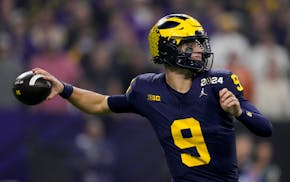The Vikings train at a complex named for orthopedists. Time to name their practice fields after an exorcist. They need both.
In 2016, a promising Vikings team lost Teddy Bridgewater less than two weeks before the season opener, quickly traded for Sam Bradford and started 5-0.
The Vikings found themselves so shorthanded on the offensive line that they signed Jake Long off the street, made the dubious decision to start him in Philadelphia, got Bradford sacked six times, went on a four-game losing streak and finished 8-8.
In 2017, a promising Vikings team lost Bradford after the season opener and Dalvin Cook early in his NFL career. It is a testament to the depth of talent on the roster that the Vikings rallied around backup quarterback Case Keenum to win 14 games.
In 2018, the Vikings entered training camp with what might have been the best roster in the NFL. On Thursday, the team confirmed that starting guard Nick Easton likely will miss the season because of a herniated disc.
Recent Vikings seasons have taught us that one injury to a lineman can spell doom ... or that a good team can survive even injuries to starting quarterbacks. Should this injury cause Vikings fans to panic at their usual level, or more?
Saturday, the team will start a makeshift line in the first preseason game, and will need their remaining linemen to remain healthy to have even three returning starters from the line that supported a 14-victory team last year.
Vikings General Manager Rick Spielman has built one of the league's best defenses. His first-round pick this season, Mike Hughes, looks like a spectacular athlete who could contribute quickly as a cornerback and returner.
He spent their second-round draft pick on tackle Brian O'Neill, who currently looks more like a project than a savior.
The signing of Kirk Cousins and the return of Cook give the Vikings more than enough talent at the skill positions to win big again. If the offensive line is functional.
Maybe that's all it needs to be.
Easton's injury will prompt paranoia in a fan base that is always wary of the next disappointment. If this proves to be the worst injury of the season, the Vikings should be able to function without him.
In the salary cap era, no NFL team is strong everywhere. Every team has to blend big-money stars and affordable youngsters, and pick its spots where it can survive with average players.
The 2016 season proved this. The Vikings didn't have a great offensive line, but started 5-0 because the line was adequate. The season didn't implode until they had to rely on players who didn't belong in the league.
Easton is trying to prove he is more than a journeyman. He signed as a rookie free agent out of Harvard with the Baltimore Ravens in 2015, and is with his third NFL team.
He wouldn't be the first long shot to make a career on an NFL offensive line, but a good team shouldn't collapse because a player of his pedigree got hurt.
The Vikings' latest crisis reminds why the later rounds of each draft are so important. Spielman deserves credit for building a powerhouse roster, but every GM has weaknesses. Spielman's is the offensive line.
In 2016, he spent a fourth-round draft pick on Willie Beavers. He was the only offensive lineman Spielman picked in that draft. He chose poorly.
In 2015, Spielman chose three tackles, the best of whom was T.J. Clemmings. None of the three has been useful.
In 2014, Spielman chose one offensive lineman: guard David Yankey. He was of no use.
From the time Spielman chose USC tackle Matt Kalil with the fourth pick in 2012 to his selection of Pat Elflein with the 70th pick in 2017, Spielman might as well as chosen Tony Mandarich every time he picked an offensive lineman.
Those failures are why an injury to Easton can feel like an existential threat, whether it is or not.

Souhan: In 7 possessions, Wolves' defense reaches new level

Souhan: Wolves fans made Game 1 special. Now bring on Game 2.

Souhan: Should Vikings even consider McCarthy in NFL draft?

Souhan: NAW erases Suns' lead, Game 1 advantage with big performance


